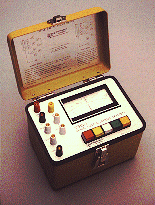Store
Vishay Model 1300 Gauge Installation Tester
Product Details
Two of the most important measurements used to verify the quality of a strain gage installation are insulation resistance (leakage to ground) and shift in gage resistance due to installation procedures. While these two measurements are not a complete guarantee of eventual proper strain gage performance, any installation that produces questionable values should not be relied upon where accuracy of results is necessary. For example, a voltage difference between the specimen and strain gage frequently exists. A low insulation resistance will permit this voltage differential to introduce extraneous signals during strain measurement. Several sources of variations in insulation resistance and shifts in gage resistance are:
•Insulation resistance in excess of 20,000 megohms should be expected for foil strain gages when installed under laboratory conditions. A value of 10,000 megohms should be considered minimum. A reading below this value generally indicates trapped foreign matter, moisture, residual flux or backing damage due to soldering, as well as incomplete solvent evaporation from an overcoating.
•Deterioration of the insulation resistance with time may be an indication of an improperly coated installation.
•At higher test temperatures, particularly above +300°F [+150°C], it is normal to expect lesser values. Ten megohms is considered to be the lower allowable value.
•Shifts in gage resistance during installation should not normally exceed 0.5% when using room-temperature-curing adhesives. Resistance shifts greater than 0.5% generally indicate damage to the gage due to improper handling or clamping. However, strain gages installed using elevated-temperature-curing adhesives may exhibit greater shifts in resistance due to adhesive lock-up at elevated temperatures (difference in linear coefficient of thermal expansion between the strain gage and specimen). These shifts will vary depending upon the specific cure temperature and materials used. The shifts should never exceed 2% and should be uniform within 0.5%.
Vishay Model 1300 Gauge Installation Tester
Powered by Lightspeed
Display prices in:CAD

